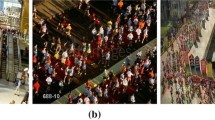Abstract
Crowd collectiveness measuring has attracted a great deal of attentions in recently years. We adopt the path integral descriptor idea to measure the collectiveness of a crowd system. A new path integral descriptor is proposed by exponent generating function to avoid parameter setting. Several good properties of the proposed path integral descriptor are demonstrated in this paper. The proposed path integral descriptor of a set is regard as the collectiveness measure of a set, which can be a moving system such as human crowd, sheep herd and so on. Self-driven particle (SDP) model and the crowd motion database are used to test the ability of the proposed method in measuring collectiveness.
This work is subsidized by National Natural Science Foundation of China under Grant 71673293.
Access this chapter
Tax calculation will be finalised at checkout
Purchases are for personal use only
Similar content being viewed by others
References
Zhang, W., Zhao, D., Wang, X.: Agglomerative clustering via maximum incremental path integral. Pattern Recogn. 46(11), 3056–3065 (2013)
Moussaid, M., Garnier, S., Theraulaz, G., Helbing, D.: Collective information processing and pattern formation in swarms, flocks, and crowds. Topics Cogn. Sci. 1, 469–497 (2009)
Couzin, I.: Collective cognition in animal groups. Trends Cogn. Sci. 13, 36–43 (2009)
Ballerini, M., et al.: Empirical investigation of starling flocks: a benchmark study in collective animal behaviour. Anim. Behav. 76, 201–215 (2008)
Zhou, B., Wang, X., Tang, X.: Understanding collective crowd behaviors: learning a mixture model of dynamic pedestrian-agents. In: Proceedings of IEEE Conference Computer Vision and Pattern Recognition (CVPR 2012) (2012)
Lin, D., Grimson, E., Fisher, J.: Learning visual flows: a lie algebraic approach. In: Proceedings of IEEE Conference Computer Vision and Pattern Recognition (CVPR) (2009)
Zhang, H., Ber, A., Florin, E., Swinney, H.: Collective motion and density fluctuations in bacterial colonies. Proc. Natl. Acad. Sci. 107, 13626–13630 (2010)
Feynman, R.P.: Space-time approach to non-relativistic quantum mechanics. Rev. Mod. Phys. 20, 367–387 (1948)
Kleinert, H.: Path Integrals in Quantum Mechanics, Statistics, Polymer Physics, and Financial Markets, 3rd edn. World Scientific, Singapore (2004)
Rudnick, J., Gaspari, G.: Elements of the Random Walk: An Introduction for Advanced Students and Researchers. Cambridge University Press, Cambridge (2004)
Zhou, B., Tang, X., Zhang, H., et al.: Measuring crowd collectiveness. IEEE Trans. Pattern Anal. Mach. Intell. 36(8), 1586–1599 (2014)
Zhang, W., Wang, X., Zhao, D., Tang, X.: Graph degree linkage: agglomerative clustering on a directed graph. In: Fitzgibbon, A., Lazebnik, S., Perona, P., Sato, Y., Schmid, C. (eds.) ECCV 2012. LNCS, vol. 7578, pp. 428–441. Springer, Heidelberg (2012). doi:10.1007/978-3-642-33718-5_31
Biggs, N.: Algebraic Graph Theory. Cambridge University Press, Cambridge (1993)
Knuth, D.E.: The Art of Computer Programming, Volume 1 Fundamental Algorithms, 3rd edn. Addison-Wesley, Reading (1997)
Vicsek, T., Czirók, A., Ben-Jacob, E., Cohen, I., Shochet, O.: Novel type of phase transition in a system of self-driven particles. Phys. Rev. Lett. 75, 1226–1229 (1995)
Buhl, J., Sumpter, D., Couzin, I., Hale, J., Despland, E., Miller, E., Simpson, S.: From disorder to order in marching locusts. Science 312, 1402–1406 (2006)
Raafat, R.M., Chater, N., Frith, C.: Herding in humans. Trends Cogn. Sci. 13, 420–428 (2009)
Zhao, D., Tang, X.: Cyclizing clusters via zeta function of a graph. In: Advances in Neural Information Processing Systems, pp. 1953–1960 (2009)
Liou, M.L.: A novel method of evaluating transient response. Proc. IEEE 54(1), 20–23 (1966)
Tomasi, C., Kanade, T.: Detection and tracking of point features. Int. J. Comput. Vis. (1991)
Chapelle, O., Zien, A.: Semi-supervised classification by low density separation. In: Proceedings of the 10th International Workshop on Artificial Intelligence and Statistics, pp. 57–64 (2005)
Author information
Authors and Affiliations
Corresponding author
Editor information
Editors and Affiliations
Rights and permissions
Copyright information
© 2016 Springer Nature Singapore Pte Ltd.
About this paper
Cite this paper
Ren, WY., Li, GH., Ling, YX. (2016). Crowd Collectiveness Measure via Path Integral Descriptor. In: Tan, T., Li, X., Chen, X., Zhou, J., Yang, J., Cheng, H. (eds) Pattern Recognition. CCPR 2016. Communications in Computer and Information Science, vol 662. Springer, Singapore. https://doi.org/10.1007/978-981-10-3002-4_18
Download citation
DOI: https://doi.org/10.1007/978-981-10-3002-4_18
Published:
Publisher Name: Springer, Singapore
Print ISBN: 978-981-10-3001-7
Online ISBN: 978-981-10-3002-4
eBook Packages: Computer ScienceComputer Science (R0)




